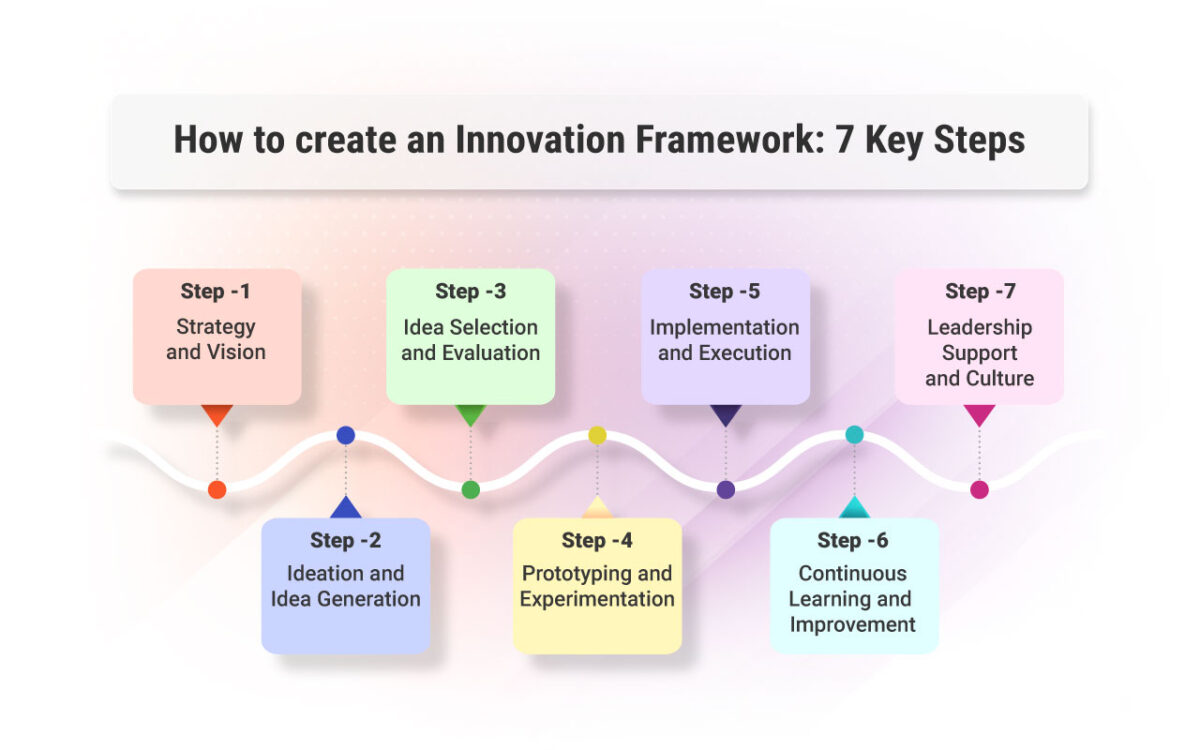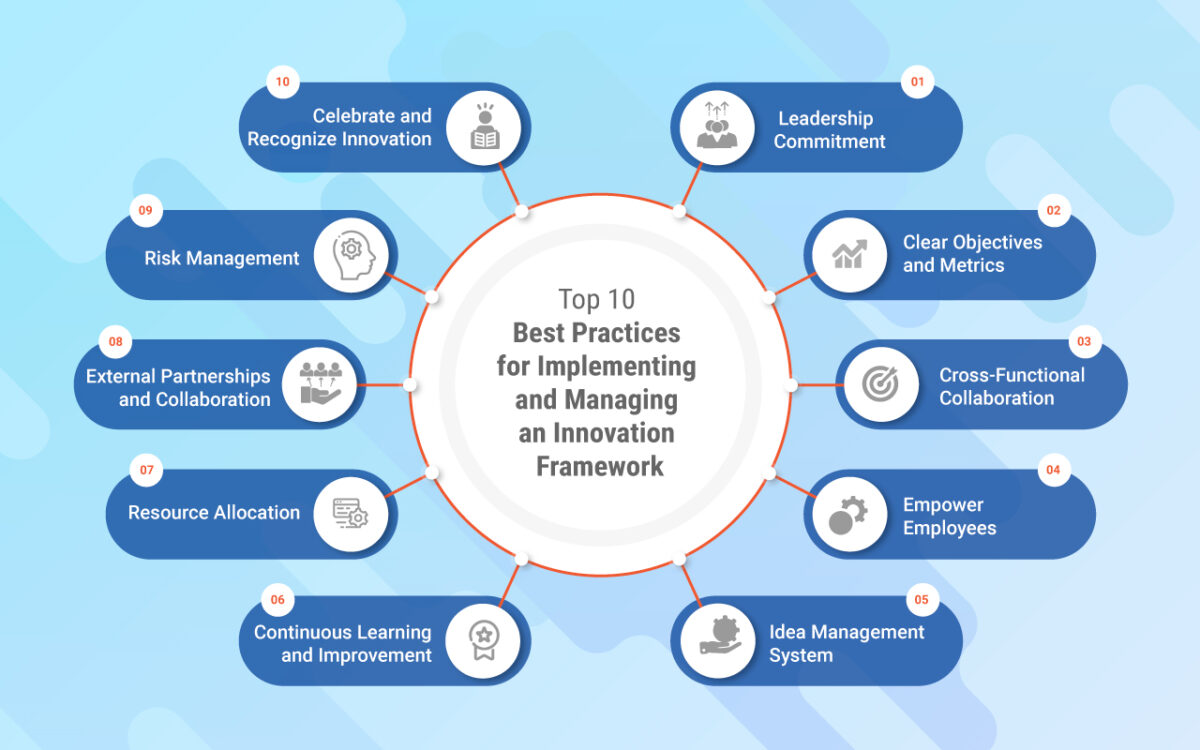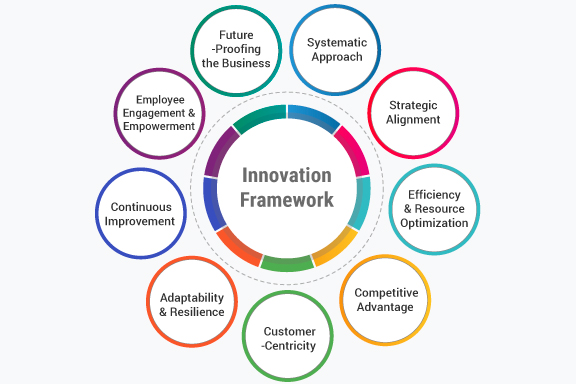What is an Innovation Framework?
An innovation framework is defined as a structured approach or methodology that guides organizations in the systematic and intentional pursuit of innovation. It provides a systematic and repeatable process for fostering innovation by generating ideas, implementing and scaling these ideas to create real business solutions.
An innovation framework helps organizations navigate the complexities of the innovation process, ensuring that efforts are focused, resources are allocated effectively, and desired outcomes are achieved.
Importance of Innovation Framework for Businesses
An innovation framework is essential for businesses as it provides a structured and strategic approach to innovation, enhances competitiveness, fosters customer-centricity, promotes adaptability, and drives continuous improvement. Here are all the factors that make innovation framework key to business ideation and growth:
- Systematic Approach: An innovation framework provides a structured and systematic approach to managing innovation within a business. It helps organizations move beyond ad hoc or sporadic innovation efforts and instead establishes a consistent and intentional process for generating, evaluating, and implementing new ideas.
- Strategic Alignment: An innovation framework ensures that innovation efforts are aligned with the strategic goals and objectives of the business. It helps organizations focus their innovation activities on areas that have the greatest potential for impact and value creation. This alignment ensures that innovation initiatives contribute to the overall growth and success of the business.
- Competitive Advantage: In today’s fast-paced and dynamic business environment, innovation is a key driver of competitive advantage. An innovation framework allows businesses to differentiate themselves by developing and delivering innovative products, services, or processes. It helps businesses stay ahead of the competition, attract customers, and adapt to changing market needs.
- Efficiency and Resource Optimization: By implementing an innovation framework, businesses can optimize their resources and allocate them effectively. The framework helps in identifying and prioritizing the most promising ideas and initiatives, enabling businesses to invest their resources in projects with higher chances of success and impact. This leads to improved efficiency and resource utilization.
- Adaptability and Resilience: An innovation framework promotes a culture of adaptability and resilience within the organization. It encourages employees to embrace change, explore new ideas, and adapt to evolving market dynamics. This adaptability enables businesses to stay relevant, respond to disruptive forces, and seize emerging opportunities.
- Customer-Centricity: An effective innovation framework places customers at the center of the innovation process. It encourages businesses to deeply understand customer needs, pain points, and aspirations. By focusing on customer-centric innovation, businesses can develop solutions that truly address customer needs, enhance customer satisfaction, and build long-term customer loyalty.
- Continuous Improvement: An innovation framework fosters a culture of continuous improvement and learning. It encourages businesses to learn from both successes and failures, iterate on ideas, and refine their innovation practices. This continuous improvement mindset ensures that the organization’s innovation capabilities evolve and improve over time.
- Employee Engagement and Empowerment: Implementing an innovation framework empowers employees to contribute their ideas and be actively involved in the innovation process. It promotes employee engagement, fosters a sense of ownership and pride, and creates a collaborative and innovative work environment. Engaged and empowered employees are more likely to contribute innovative ideas and drive the organization’s success.
- Future-Proofing the Business: An innovation framework helps businesses future-proof themselves by embracing change and proactively seeking new opportunities. It enables businesses to anticipate market trends, identify emerging technologies, and explore business model innovation. This forward-looking approach helps businesses adapt and thrive in an ever-evolving business landscape.
Learn more: What is Innovation Management?
How to create an Innovation Framework: 7 Key Steps

The key steps for an innovation framework typically include:
Step 1. Strategy and Vision
Clearly define the organization’s innovation strategy and vision. This involves setting goals, identifying focus areas, and aligning innovation efforts with the overall business strategy. The strategy and vision provide a roadmap for innovation activities and guide decision-making throughout the process.
Step 2. Ideation and Idea Generation
Establish processes and methodologies for generating, capturing, and evaluating ideas. This involves creating a culture that encourages and supports ideation, implementing tools and techniques for ideation sessions, and fostering collaboration to generate a diverse range of ideas.
Step 3. Idea Selection and Evaluation
Develop criteria and mechanisms for evaluating and selecting the most promising ideas. This involves defining evaluation criteria aligned with strategic goals, assessing the feasibility and potential impact of ideas, and involving relevant stakeholders in the decision-making process.
Step 4. Prototyping and Experimentation
Emphasize the importance of prototyping and experimentation to validate and refine ideas. This component involves creating a culture of experimentation, developing rapid prototyping capabilities, and implementing processes to gather customer feedback and insights from early prototypes.
Step 5. Implementation and Execution
Develop processes and structures to effectively implement and execute innovative ideas. This involves project management, milestone tracking, and performance measurement to ensure that ideas are implemented successfully and deliver the desired outcomes.
Step 6. Continuous Learning and Improvement
Foster a culture of continuous learning and improvement by capturing insights and lessons learned from innovation initiatives. This component involves feedback loops, post-implementation reviews, and knowledge-sharing mechanisms to enhance future innovation efforts based on past experiences.
Step 7. Leadership Support and Culture
Ensure that leadership actively supports and champions innovation initiatives. This component involves cultivating a culture that values and rewards innovation, fostering an environment that embraces risk-taking and learning from failures, and empowering employees to contribute to the innovation process.
Besides these steps to create the innovation framework, it is always important to establish metrics and key performance indicators (KPIs) to assess the effectiveness and impact of innovation efforts.
Learn more: What is Business Innovation?
Types of Innovation Framework
Here are ten types of innovation frameworks commonly used by organizations:
- Open Innovation Framework: Open innovation involves collaborating with external partners, such as customers, suppliers, or research institutions, to exchange knowledge, ideas, and resources for innovation. It focuses on leveraging external expertise to drive innovation within the organization.
- Blue Ocean Strategy Framework: Blue Ocean Strategy aims to create uncontested market space by identifying and developing innovative products or services that differentiate the organization from its competitors. It involves shifting the focus from competing in existing market spaces to creating new market opportunities.
- Disruptive Innovation Framework: Coined by Clayton Christensen, disruptive innovation refers to the development of new products or services that initially cater to niche markets but eventually disrupt established markets. This framework emphasizes the importance of identifying and capitalizing on opportunities to disrupt existing industries.
- Business Model Innovation Framework: Business model innovation involves reimagining and reinventing the way an organization creates, delivers, and captures value. It focuses on transforming or creating new business models to gain a competitive edge and capture new market opportunities.
- Design Thinking Framework: Design thinking is a human-centered approach that emphasizes empathy, problem-solving, and creative thinking to drive innovation. It involves understanding user needs, ideating solutions, prototyping, and iterating based on user feedback.
- Lean Startup Framework: The lean startup framework is centered around building and launching minimum viable products (MVPs) to quickly test assumptions and gather user feedback. It focuses on a cycle of Build-Measure-Learn to iteratively refine products or services based on validated learning.
- Customer-Centric Innovation Framework: This framework revolves around deeply understanding customer needs, pain points, and desires. It involves gathering customer insights, conducting market research, and leveraging customer feedback to drive innovation and create value for customers.
- Platform Innovation Framework: Platform innovation involves developing a platform or ecosystem that enables the integration of multiple products, services, or technologies. It focuses on creating a network effect, where the value of the platform increases as more participants join and contribute.
- Sustainability and Green Innovation Framework: This framework emphasizes developing environmentally sustainable solutions and practices. It involves incorporating environmental considerations into product design, supply chains, and operations, aiming to minimize environmental impact and create more sustainable business models.
- Co-Creation Framework: Co-creation involves involving customers, partners, and other stakeholders in the innovation process. It focuses on collaborative idea generation, co-design, and co-development to create solutions that align closely with the needs and preferences of the intended users.
These innovation frameworks provide organizations with structured approaches and methodologies to drive innovation, differentiate themselves in the market, and create value for customers and stakeholders. Organizations can choose the framework(s) that best align with their strategic goals, industry, and organizational culture.
Top 10 Best Practices for Implementing and Managing an Innovation Framework

Strategically implementing and managing an innovation framework requires careful planning and execution. Here are the best practices:
1. Leadership Commitment
Ensure that senior leadership actively supports and champions the innovation framework. Leaders should communicate the importance of innovation, allocate resources, and provide a clear vision and direction for the organization’s innovation initiatives.
2. Clear Objectives and Metrics
Define clear objectives and key performance indicators (KPIs) to measure the success of the innovation framework. These metrics should align with the organization’s strategic goals and provide a way to track progress and evaluate the effectiveness of innovation efforts.
3. Empower Employees
Create a culture that empowers employees to contribute to the innovation process. Encourage them to generate and share ideas, take calculated risks, and learn from failures. Provide training and development opportunities to enhance their innovation skills and mindset.
4. Cross-Functional Collaboration
Foster collaboration and cross-functional teamwork. Break down silos and encourage the exchange of ideas and knowledge across different departments or business units. This collaboration can spark creativity, promote diverse perspectives, and enhance the quality of innovation outcomes.
5. Idea Management System
Implement an idea management system or platform to capture, evaluate, and track ideas throughout the innovation lifecycle. This system should provide a centralized repository for ideas, enable collaboration and feedback, and facilitate the evaluation and selection of ideas for implementation.
6. Resource Allocation
Allocate resources, including financial, human, and technological resources, to support innovation initiatives. Ensure that resources are aligned with strategic priorities and allocated based on the potential impact and feasibility of innovation projects.
7. Continuous Learning and Improvement
Promote a culture of continuous learning and improvement within the innovation framework. Regularly review and evaluate innovation projects, gather customer feedback, and capture lessons learned. Use this knowledge to refine and enhance the innovation processes and practices over time.
8. Risk Management
Implement a risk management framework to assess and mitigate potential risks associated with innovation initiatives. Encourage calculated risk-taking while considering the potential impact on the organization’s resources, reputation, and strategic goals.
9. Celebrate and Recognize Innovation
Recognize and celebrate innovative ideas, projects, and contributions from employees. This recognition can serve as a motivator and reinforce the value and importance of innovation within the organization. Consider implementing rewards or recognition programs to incentivize and encourage innovation.
10. External Partnerships and Collaboration
Explore partnerships with external organizations, such as startups, research institutions, or industry experts, to tap into their expertise, access new technologies, and expand innovation capabilities. Collaborative partnerships can accelerate innovation and provide access to new markets or customer segments.
By following these best practices, organizations can effectively implement and manage an innovation framework, foster a culture of innovation, and drive meaningful and sustainable innovation outcomes.
Learn more: What is Product Innovation?
Most Recent Blogs
Explore the latest innovation insights and trends with our recent blog posts.










